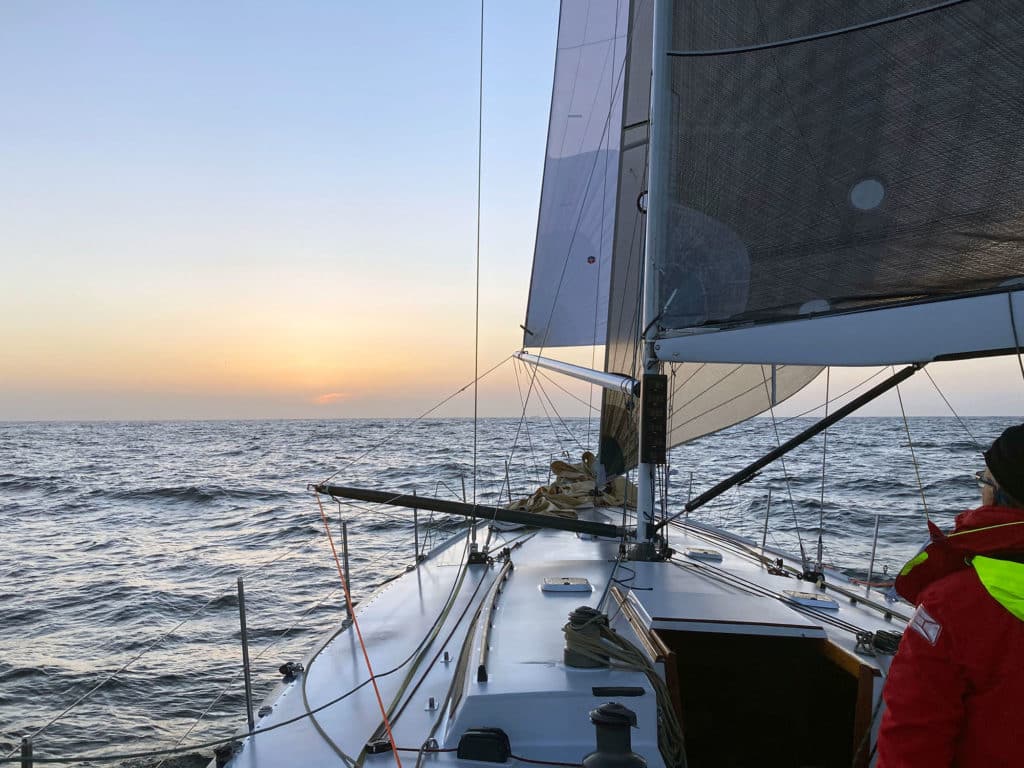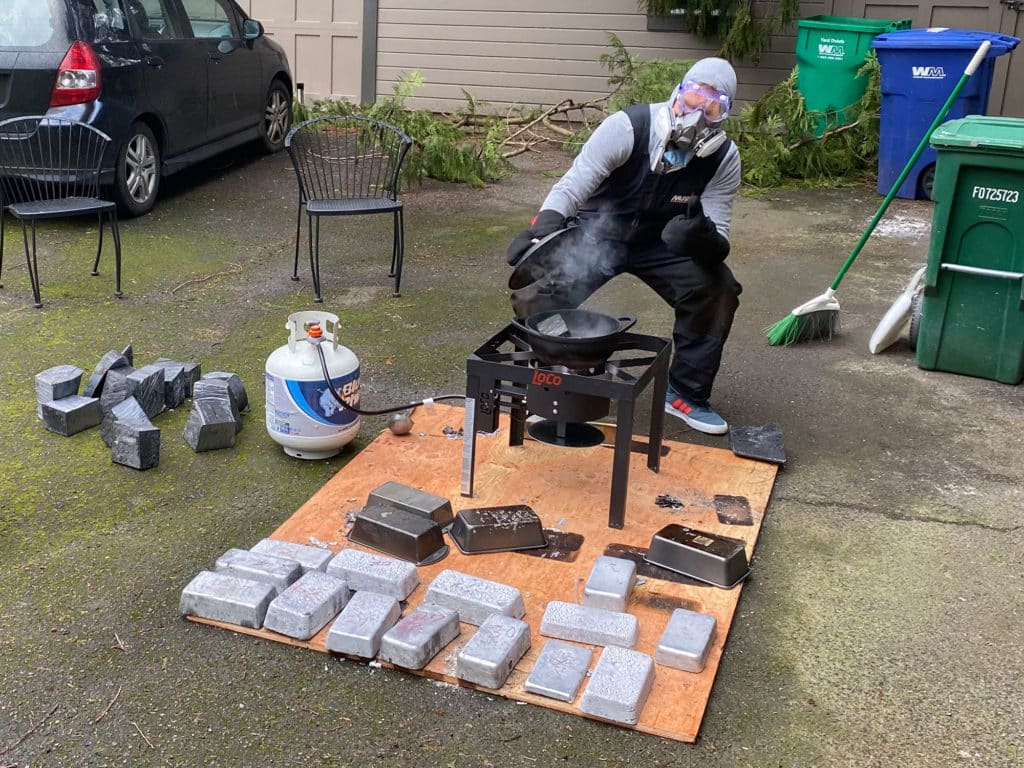
Cape Disappointment, at the mouth of Oregon’s Columbia River, is a lonely place in late winter. It can be windy and the water is always cold. Air temperatures hover near freezing. Fishing boats are the only vessels you’re likely to see plying this remote piece of the North Pacific. But on this day in March there’s a dark blue Santa Cruz 70 heading south at pace. It’s Pied Piper, owned by 41-year-old Jack Jennings. The youngster and his crewmates are San Francisco bound and then Los Angeles for the start of the 2021 Transpac Race in Los Angeles.
“We stuck out like a sore thumb,” says Jennings. “Nobody sails around there, especially that time of year.”
En route to San Francisco, they would cover 300 miles in one 24-hour period, which is really fast for a SC70—especially one built more than three decades ago. “At night it was 30 degrees, and you could see your breath down below,” Jennings says. “That’s when I knew these were the guys I wanted with me on the Transpac. I didn’t really care what the results were going to be because that type of stuff—the challenging delivery, bringing these guys together and having that kind of adventure—I loved that part of it.”
Four months later, Jennings and his crew would sail Pied Piper to first in its class and third overall in the Transpac while recording the fastest time for a traditional sled and breaking the old record by three hours. Yet, the journey and bringing people together—what originally motivated Jennings at the outset—and successfully complete—this project—is the real story here.
Jennings purchased the boat from Orange Coast Community College in 2019 with an eye toward getting it in shape for the 2020 Pacific Cup and the Transpac the following year. He had it delivered north to Portland because, “It was the cheapest place to put the boat, and it was where we could afford some decent housing,” an essential he and his crew would need, given the boat’s condition.
Formerly Holua, the 70-footer had languished for three years dockside in the California sun, used only for an occasional charter. “All the rigging was shot, the electronics were toast, and the [sail] inventory wasn’t so hot,” Jennings says, “but it had good bones—mast, hull, good keel, rudder, everything we needed to get started.”
When the hard labor began Jennings knew what he was getting into. He cut his teeth on his father’s SC70 of the same name on the Great Lakes—the boat that set a Chicago to Mackinac Race record that stood for 10 years. That boat was sold after his father, Dick Jennings, died in 2011, but Jack never lost his affinity for the design—or the love of sailing, which his father clearly inspired. “Every time I go sailing, I think of my dad,” he says. “That’s why all the boats I sail are called Pied Piper. It’s a big motivation and legacy to keep that name going.”
RELATED: Moving Targets For Transpac and Others
The name, of course, is a nod to the legend of the Pied Piper of Hamelin who saved a small town from a rat infestation, and to the family’s Chicago-based company, Smithereen Pest Management Services.
The idea of a run at the Transpac Race came to Jennings while attending a Finn clinic in Valencia, Spain, in 2019. He recalls sitting by himself at the yacht club one sunny afternoon, waiting for the sea breeze to appear, laptop in front of him. Peter Thorton, who owned the Volvo 70 Il Mostro, on which Jennings had been a regular, had been donated. He realized how much he missed sailing with others. “I was bummed that a lot of the friends I had made sailing on Il Mostro weren’t going to be sailing together anytime soon. I wasn’t really interested in doing a Mac race on a SC 70 again. I’d already done that. I wanted to go to the ocean and do something different.”
For Jennings, the Transpac presented a new set of challenges as well as the opportunity to reunite a lot of his mates. “One thing that really made this possible is that Andy McCormack (Smithereen’s Vice President), and I had worked really hard to make our company do well.”
So financially, the Transpac was within reach.
“I didn’t know it was going to be a SC 70, nor did I know that the team I would eventually form would be a mix of guys who sailed with my dad and those I sailed with more recently.”
His father’s SC 70 crew was of a slightly older generation, and some of the old guard hadn’t sailed for almost 15 years. Il Mostro’s crew always included a handful of professional sailors who brought with them state-of-the art approaches to everything that makes a boat go fast. “Getting as many of those people together was the whole impetus for finding a boat,” Jennings says. “As luck would have it, most of the guys had signed on to sail before the Covid pandemic hit. The schedule kept changing because of regatta cancellations but we kept working on the boat and sailing on our own until we could race again. It just happened that the first race was going to be the Transpac, so at the end of the summer of 2020, we made that our focus.”
After finding Holua, one of his first calls was to McCormack, who in addition to being his right-hand man at Smithereen was his father’s first boat captain, as far back as when Jennings was a little kid. “I said, ‘Andy, I have this idea, but I want you to be the manager, taking care of logistics, organizing the crew.’ It was obviously a massive effort to move this boat around, getting everything lined up and all the pieces in place.”
McCormack agreed, and the ball started rolling in what became a two-year process.
In late 2019, a small crew sailed Holua to Portland with an eye toward being ready for the 2020 Pacific Cup, a race from San Francisco to Hawaii. McCormack’s brother-in-law, Jamie Schwarz, who also worked as a boat captain for Jennings’ father, had just quit his job as a carpenter in Montana, and McCormack asked if he’d like to get involved in this project. “He literally sold all his stuff, moved to Portland and started working on the boat,” Jennings says.
Schwarz worked on the boat for a year in anticipation of the 2020 Pacific Cup until the pandemic pulled the plug on that event. The emphasis then shifted to the 2021 Transpac. With Kevin Miller, of North Sails Santa Barbara, and naval architect Greg Stewart, they optimized Pied Piper for the race from Los Angeles to Hawaii. Among other things, they added lead to get the boat sitting on its lines better, as well as providing a ratings advantage, and a couple of power reaching sails so they could run a triple-head rig.

“We were able to do some things with the sails that we couldn’t do 10 to 15 years ago, when I last sailed a SC 70,” Jennings says.
More importantly, he continued to recruit people he knew would be good teammates. There was trimmer Jonathan Swain, a pro sailor who had done a stint on the TP 52 Heartbreaker while Jennings was aboard. “I learned a ton watching him when we first sailed together on Il Mostro,” Jennings says. “I was a grinder, so I had a front-row seat to watch how he trimmed and handled sail changes.”
Navigator Matt Wachowicz joined the Il Mostro crew when they were having trouble with the boatspeed readout. “Other navigators came aboard and couldn’t figure it out,” Jennings says, “but Matt did it in about 10 minutes. I knew he was the guy to handle putting a new instrument package on the Pied Piper.”
Other crew members included Dave Jochum, who started the sailing team at Jennings’ high school and sailed on Pied Piper with him when he was a teenager; Matt Noble, a professional rigger whom he met A Class Catamaran sailing 10 years earlier and happened to be living in Portland when Pied Piper arrived there; Bill Wagner, another Pied Piper veteran who Jennings’ father taught to sail when he was 12; J.B. Kuppe, who delivered the boat to Portland right after its purchase; and pro bowman Ben Bardwell, a late addition and the only one Jennings had not sailed with before.
His only disappointment was the absence of Zane Gills, his former Star boat crew and teammate on Il Mostro. “He was one of the first guys I talked to about this,” says Jennings. “I told him we were going to get this boat and do the Transpac, and he was really keen on the idea.”
On January 1, 2020, Gills fell from a boat, struck his head and drowned. “He was a terrific friend and great offshore sailor. It was really unexpected, and I thought about him a lot during the whole campaign,” Jennings says.
When the boat finally arrived in Los Angeles before the race, the team spent the next three months, on and off, training aboard Pied Piper. “That training, along with the trip south from Portland, was key,” Jennings says. “We knew that when we got to the Transpac, there would be plenty of wind, but it wasn’t going to be 40 degrees. The fact that we were able to do that really showed our potential to work together as a team.”
Which takes us back to Jennings’ primary reason for creating this program. “All those people who came to the race had a shared experience,” says Jennings. “We knew what to expect from each other, we’d all been through the same challenging conditions, and all that brought the team together.”
His role in this hit home on that first night offshore, heading out from Cape Disappointment. “I had gone offshore a lot, but was always there for myself; someone invited me, and I was happy to go.”
But this was new territory for Jennings. “I never had trouble sleeping on a boat before, but that first night out of Cape Disappointment, I couldn’t. Here we are, the water’s cold, the air’s cold, it’s windy, and it suddenly occurs to me: this is my responsibility now. It’s one of those moments that really makes you stop and think. I knew then how my dad felt the first time he took a crew offshore.”
After Pied Piper crossed the finish line in the Transpac, McCormick pulled Jennings aside, put his arm around him and said, “Your dad would be proud of you.” Says Jennings, “I didn’t make a big deal about it, but that was always in the back of my mind.”









